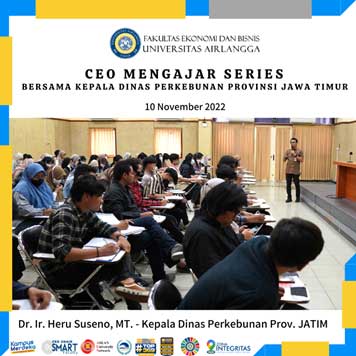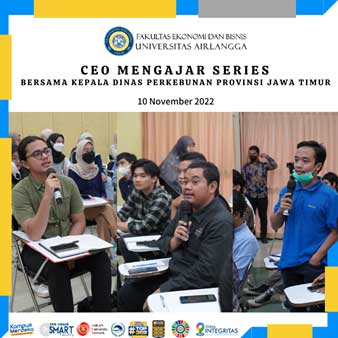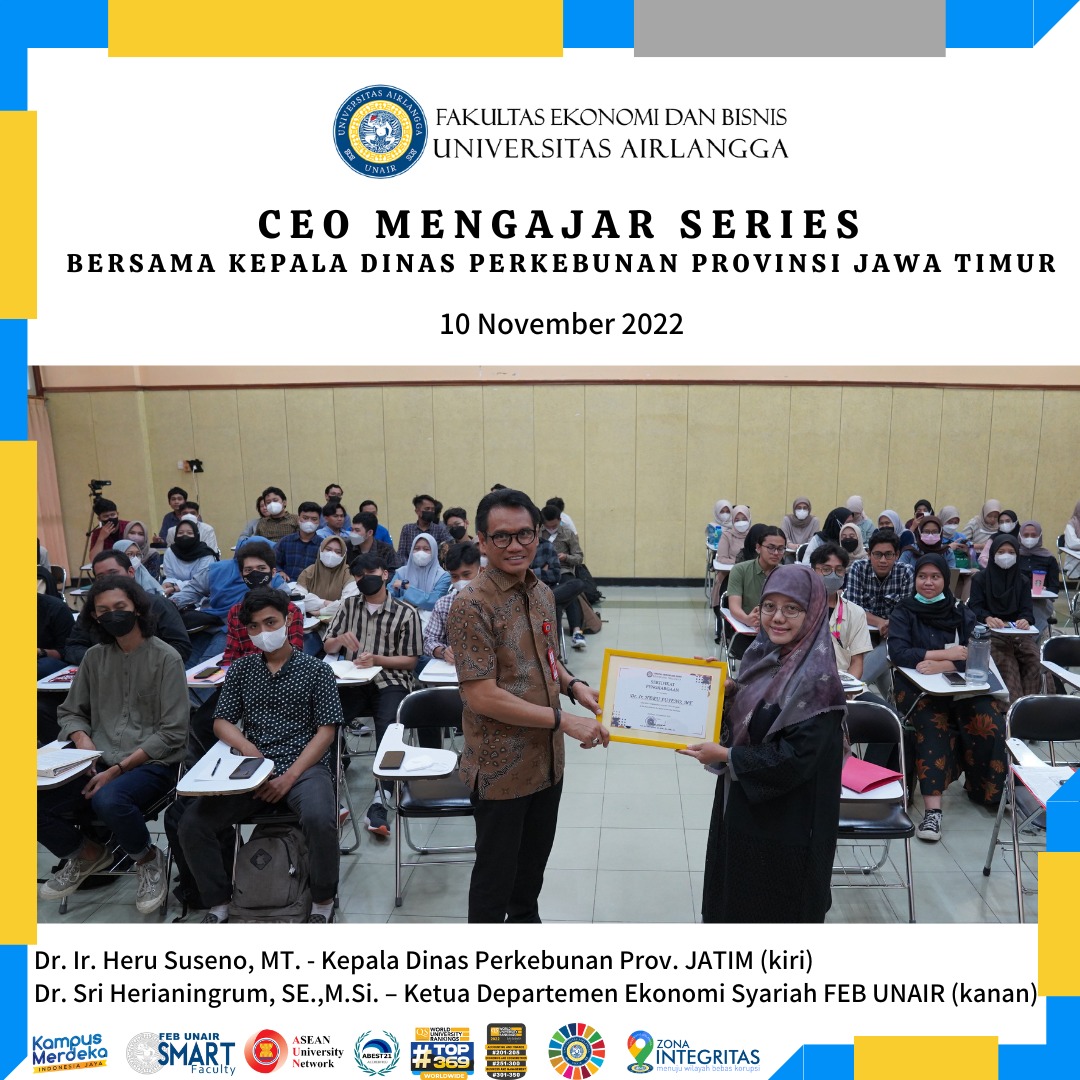 (FEB NEWS) "CEO TEACHING SERIES" for the Islamic Microeconomics Course, this time the Department of Sharia Economics, Faculty of Economics and Business, Universitas Airlangga (FEB UNAIR) under the leadership of Dr. Sri Herianingrum, SE., M.Si. – Head of the Sharia Economics Department, FEB UNAIR, invited a speaker from the East Java Province Plantation Service – Dr. Ir. Heru Suseno, MT – Head of the East Java Province Plantation Service, from Room 207, 2nd Floor FEB UNAIR, (10/11/2022).
(FEB NEWS) "CEO TEACHING SERIES" for the Islamic Microeconomics Course, this time the Department of Sharia Economics, Faculty of Economics and Business, Universitas Airlangga (FEB UNAIR) under the leadership of Dr. Sri Herianingrum, SE., M.Si. – Head of the Sharia Economics Department, FEB UNAIR, invited a speaker from the East Java Province Plantation Service – Dr. Ir. Heru Suseno, MT – Head of the East Java Province Plantation Service, from Room 207, 2nd Floor FEB UNAIR, (10/11/2022).
Dr. Ir. Heru Suseno, MT. started the lecture by explaining the business processes carried out by the Plantation Service. A series of processes are explained starting from providing quality seeds which will then be certified and their distribution monitored, then applying on-farm and off-farm cultivation techniques, as well as developing garden plants using a planting program; pluck; exercise; pack; sell. This series of processes is carried out so that plants can grow not only well but also of good quality.
He also explained that economic growth in the plantation sub-category in the third quarter was 1.22%, while the contribution of Gross Regional Domestic Product (GRDP) in the plantation sub-category also increased in the third quarter by 2.5%. The significant increase in AHDB and AHDK GDP from Quarters I and II was due to sugar cane and tobacco having a harvest/production schedule in Quarter III each year.
In his presentation, Dr. Ir. Heru Suseno, MT. explained that as many as 77,009 hectares were people's plantations. Therefore, the government is responsible for the welfare of its people. The types of commodities are divided into two, namely annual commodities and annual commodities. Various types of superior plants represent East Java in the national realm.
Dr. Ir. Heru Suseno, MT. explained that the amount of sugar cane in East Java in 2022 is predicted to be above that in 2021, namely around 200 thousand to 500 thousand tons. The government keeps the price of sugar good only for consumption, because if production is freed up then there will be a lot of goods and prices will decrease. So the production is only for consumption. He explained that East Java Province would become the largest producer of white crystal sugar in 2021, where Malang City would become the largest producer of crystal sugar.
Next Dr. Ir. Heru Suseno, MT. tells about a very interesting coffee commodity. Coffee in East Java is ranked in the top 5 as the largest national producer. However, even though it is not the largest commodity, the type of coffee in East Java is no less competitive with coffee from Aceh, namely Gayo Coffee. Coffee in East Java consists of Arabica and Robusta coffee. Robusta coffee produced reached 55,047 tons, while Arabica coffee produced a smaller amount. The largest coffee producer in East Java is also in Malang City, namely 28.1%. Because Indonesia is one of the largest coffee producing countries, a lot of coffee is exported abroad. Almost all countries are destinations for coffee exports from Indonesia.
Dr. Ir. Heru Suseno, MT. also explained that cocoa (chocolate) in East Java is in 9th place because production is not very large. Very few farmers are interested in producing chocolate because the production process is a bit complicated and expensive. The largest cocoa areas are along the south coast and parts of the central region of East Java. The largest chocolate production in East Java is in Blitar City, namely 14.5%.
Presentation by Dr. Ir. Heru Suseno, MT. made students interested in the lecture and invited their curiosity about plantations in Indonesia, especially East Java.
Greetings, keep fighting for whatever we have to achieve.
FEB ONE
UNAIR GREAT
FEB ONE FOR UNAIR AND INDONESIA


























